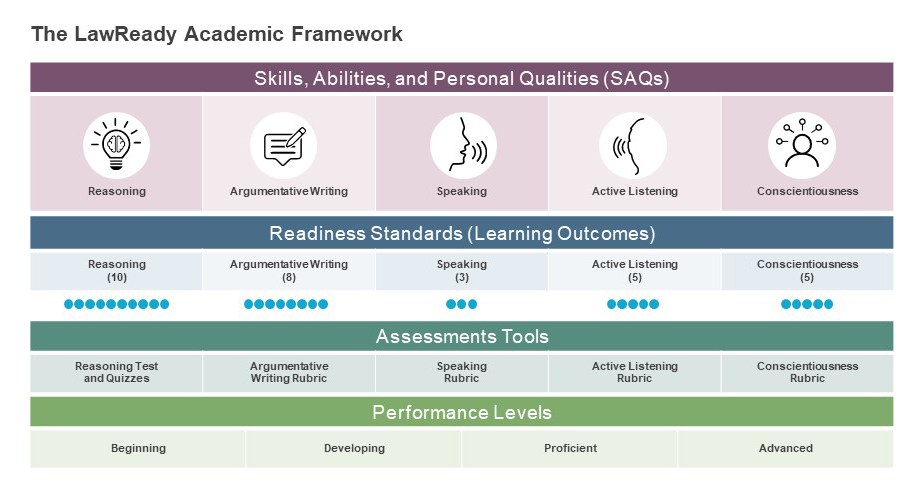The Academic Pillar of LawReady™: A Roadmap to Readiness
By Tony Shiver and Krista Mattern
Last month, we began a blog series highlighting the three pillars of LawReady, starting with the navigation pillar. This month, we’re continuing the series by focusing on the program’s academic pillar. The goals of the academic pillar of LawReady are twofold:
- Support students in developing the skills and abilities critical for success in law school.
- Provide a way for students to demonstrate that they have the skills and abilities critical for success in law school.
To accomplish these goals, we have developed a roadmap to law school readiness that enables students, faculty, and prelaw advisors to understand what matters in their preparation, periodically check in on their progress, and make course corrections during their undergraduate experience.
LawReady is designed so that students can achieve these goals as part of their undergraduate experience by aligning existing institutional courses to LawReady. To that end, we have developed the Academic Framework, which is broken down into skills, abilities, and personal qualities (SAQs); standards; assessments; and performance levels to support students in achieving their goal of law school readiness.

Academic Framework
At the highest level of LawReady’s academic framework are the nine SAQs that contribute to law school readiness, which were identified from a review of previous research and data in this area. These include reasoning, argumentative writing, speaking, active listening, time management, effort, attention to detail, constructive collaboration, and open-mindedness. For each of the nine SAQs, we developed standards or learning outcomes in collaboration with law and undergraduate faculty through a standard-setting workshop. The LawReady standards provide an additional level of detail by articulating what students should know and be able to do for each of the LawReady SAQs.
The next level of framework includes a series of aligned assessments and scoring rubrics. The LawReady assessments measure students’ progress towards law school readiness. To facilitate the interpretation of performance on the LawReady measures, we have developed performance level descriptors. Performance on each of the LawReady measures is classified into four levels — advanced, proficient, developing, or beginning — providing students with feedback on their current standing on each LawReady SAQ.
LawReady in the Classroom
LawReady schools align their existing courses to the LawReady learning outcomes/standards, allowing for visibility into which courses contribute the greatest to ensuring students gain the foundational skills that are critical for success in law school and beyond. By explicitly identifying courses as LawReady-aligned, schools will be providing students with a course selection “roadmap” in terms of identifying courses that are most likely to help them achieve their goal of law school readiness. LSAC will provide advice on program implementation as needed and desired, but schools will be encouraged to make the program their own by aligning their own unique curricula and course offerings to the LawReady standards.
For students to succeed in LawReady, it is crucial that they receive regular and informative feedback on their progress toward the program goals. LawReady will provide professors with tools to facilitate this feedback. Some of the tools are grading rubrics that organize the performance level descriptors in a way that can be used to both guide and judge students’ academic performance (e.g., on essays or oral presentations). Others are multiple-choice assessments, organized by the type of reasoning exhibited in the questions, that can be deployed as quizzes or skill-checks in reasoning courses. There will also be a longer, summative test of reasoning skills that can be used in place of, or as a complement to, final exams.
The LawReady assessments and associated delivery model are designed to support effective pedagogy by providing frequent, reliable, and valid feedback on the SAQs related to law school success throughout a LawReady course. LawReady professors and students will be tapping into LSAC’s unparalleled expertise in designing fair and reliable tests for law school admission. The multiple-choice quizzes and tests, for example, have been developed using the same methodology, and the same crew of writers, that have made LSAT scores the single best predictor of performance in law school.
Program Outcomes — Digital Portfolio and LawReady Certificate
LawReady will summarize students’ academic progress in a digital portfolio and a program dashboard. As students are evaluated via the LawReady assessments, qualifying scores will trigger the issuance of digital badges indicating that a student has satisfied the requirements of a given performance level of one of the LawReady SAQs. The badges will include the relevant standards satisfied, qualifying scores, and/or the actual work that was scored as evidence of the student’s achievement. Badges and other relevant outcome indicators will be displayed in the dashboard, which will empower students to maximize their own personal strengths and shore up any revealed weaknesses. When a LawReady student applies for admission to law school, a summary of their performance in LawReady courses will be included in the application to showcase the student’s commitment to pursuing legal education and the many achievements they accrued along the way.
In addition to a digital portfolio, students who demonstrate proficiency on the LawReady SAQs will earn the LawReady certificate, signaling readiness for law school. We are currently conducting two research studies — one with undergraduate institutions and one with law students and faculty — to examine the relationship between the new LawReady measures and performance on the LSAT and first-semester law school GPA in order to collect validity evidence in support of use of the LawReady certificate for law school admission.


